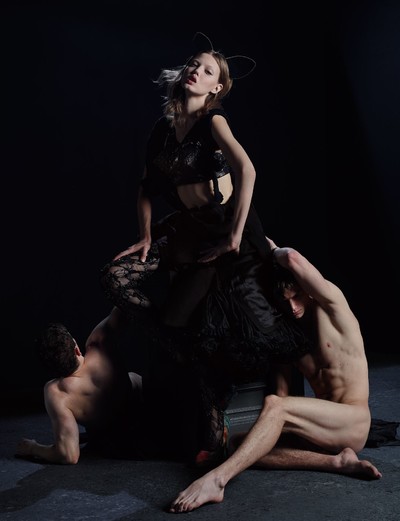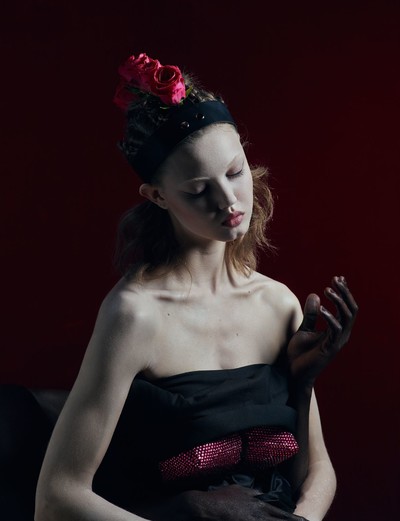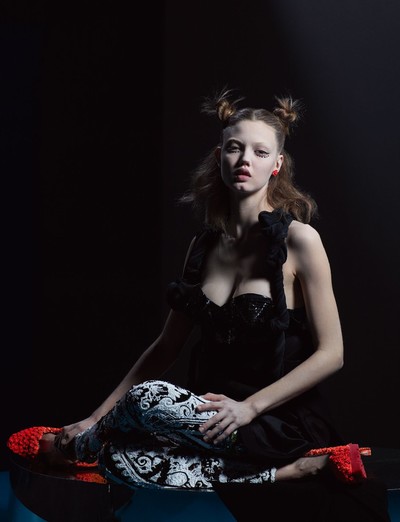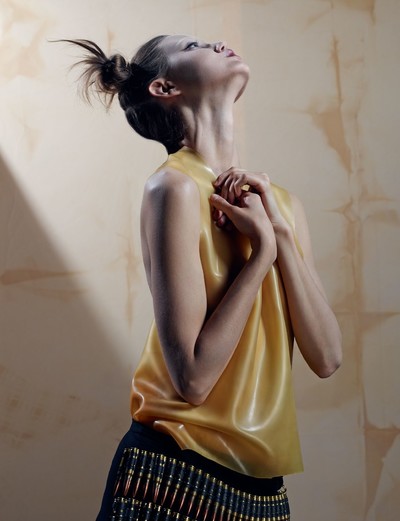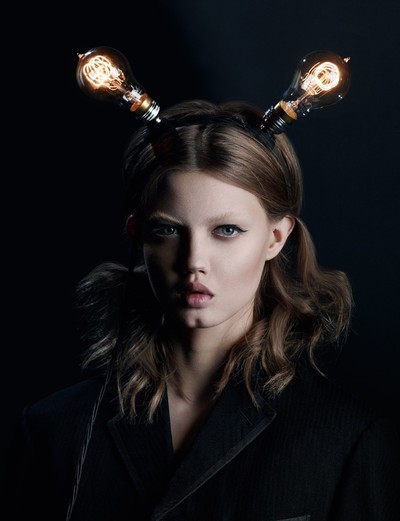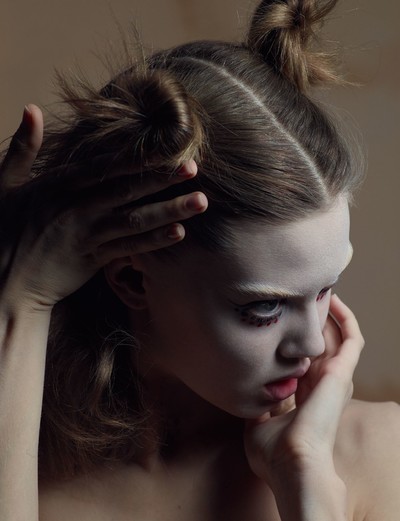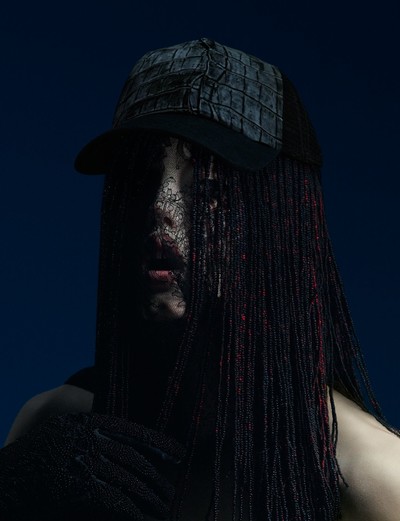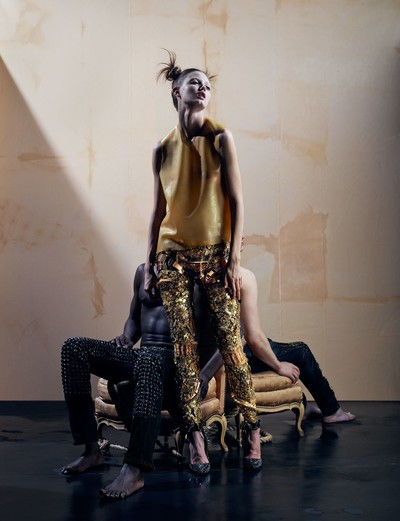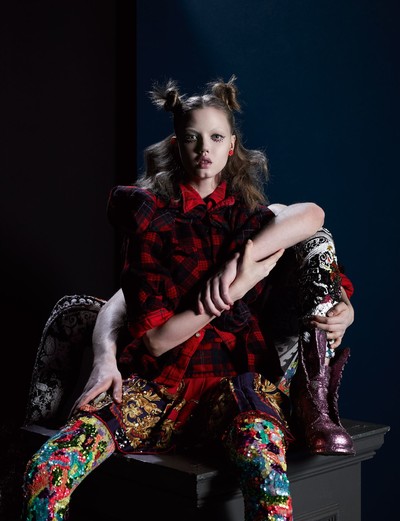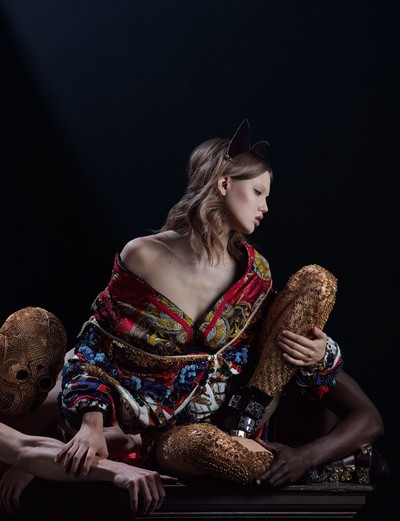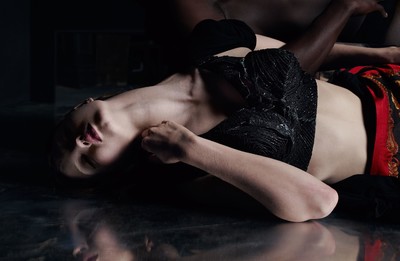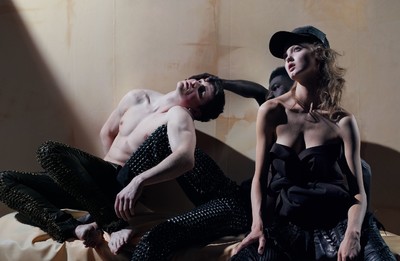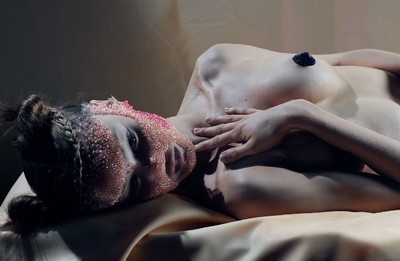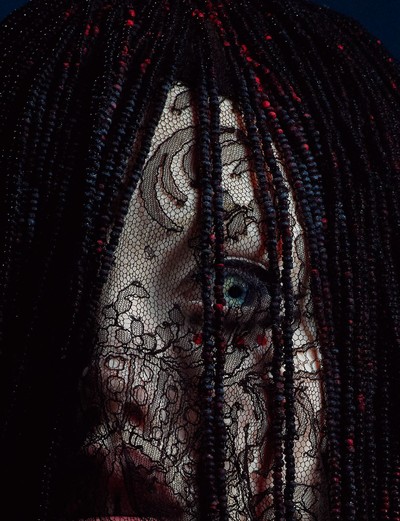The only stylist with an army of seamstresses, Panos Yiapanis recreates his archive of unique custom-made pieces.
By Alexander Fury
Styling by Panos Yiapanis
Photographs by Matthew Stone
The only stylist with an army of seamstresses, Panos Yiapanis recreates his archive of unique custom-made pieces.
Panos Yiapanis asks to be interviewed in the Primrose Bakery, close to London’s Camden Town. Camden is somewhere I’d associate with Panos: it’s sort of gritty, a bit grungy and punky – both epithets Panos applies to his work during our discussion, albeit disparagingly. It’s decidedly dark, and distantly un-fashion. Something everyone assumes also of Panos.
However, Primrose Bakery is neither of those things, and not very Panos to boot. There isn’t a scrap of black in the place for a start, until Panos arrives with his Rottweiler, Beast – who is affectionate and sweet and not much of a beast at all despite being the size of a Shetland pony. But Primrose Bakery is close to Panos’ home, and Panos hasn’t been to bed. He was shooting the editorial that accompanies this interview until roughly 3am. ‘Then I had to wait for all the stuff to be packed, I had to drop some stuff off… I didn’t get to bed until 9:30 or something ridiculous,’ he sighs. ‘So that makes me a little… incoherent. My sentences are slightly nonsensical today.’ Panos also likes cake. So the locale is unexpectedly perfect.
Panos Yiapanis is one of the most important stylists working in the world today. Undoubtedly. Interestingly, unlike his peers, Panos hasn’t risen to the top of the game via a high-profile collaboration with a single designer, or from styling an even higher-profile pop superstar or celebrity mogul. He’s done both of those things of course; his collaboration with Rick Owens stretches right back to the designer’s first catwalk shows a dozen years ago. He was also one of the earliest and most significant collaborators when Riccardo Tisci joined the house of Givenchy.
But Panos’ reputation has been built on editorial work, work he dubs ‘indulgent’, allowing him to explore notions entirely of his own imagining. These are the magazine tears that wallpaper teenage fashion fans’ walls, because what Panos consistently proposes is an alternative to the anodyne fashion image. His is one of a handful of aesthetics that really matter on the international fashion scene.
More than any other stylist, Panos Yiapanis is the author of his imagery – quite literally in that many of the pieces will have been created by Panos’ own studio, a buzzing hive of activity that churns out everything from studded leggings to bejewelled high heels. I myself have always wondered if there’s a frustrated fashion designer inside Panos, aching to get out. Although after a decade and a half in the industry, if he had wanted to pursue that path, he would have put that plan into motion. Instead, he uses it to embellish and augment designers’ fashion, of any particular season, and in the process turns it into his own.
‘So much of what I do is dependent on the photographers. It’s one way of being able to sneak myself into the picture.’
Alexander Fury: How did you select the pieces you wanted to shoot?
Panos Yiapanis: The initial selection was more to do with things that might still be relevant today somehow. There are certain things that I have an attachment to, certain pieces we’ve made which I feel have been more successful than others. Often things get dismantled and made into other pieces. A lot of the stuff doesn’t actually exist anymore. So it was also a logistical consideration, in terms of getting everything done on time. We didn’t get around to shooting everything. When I was in the cab on the way home I was remembering things that we’d made but hadn’t got round to shooting – bummer!
It’s interesting to think about that idea, whether or not the pieces have stood the test of time.
Not a lot of them have, it’s kind of strange. Obviously when I first started, I did a lot of things that would be considered ‘punky’ or ‘grungy’, all of that. A lot of denim, that now would look… not irrelevant, but slightly dated.
I wonder if that is just you relating them very strongly to an older shoot – this is so 2003, I can’t possibly use this.
At one point, we were making a lot of over-embroidered print pieces. And now I can’t think of anything worse. We covered a bit of it in this shoot, and it works as an image because the print and the embroidery oversaturate the image, but as a garment in itself, they become a little banal.
The funny thing is, the stuff is never made to have a life…
It’s not made with the intention of surviving after the shoot?
It’s purely a visual aid. Sometimes, we make something that ends up resembling an outfit, for the fun of it. But that’s never the intention when we start out on a shoot. That’s why it’s never transpired into anything other than those items made specifically for shoots, as opposed to anything with the intention of being a real garment.
They are satisfying a visual need?
They’re kind of a crutch. A very easy way to make a picture identify itself with me. It’s also become a little bit of a formula. If I don’t do it, people feel like I’ve not really made an effort. If I don’t show up with a little bag of tricks, it’s almost – well, why are you here then? But it’s fine. Like I’ve said in the past, I can’t do… the other type of styling, let’s just put it that way. It helps. It kind of gives it an identity, some kind of visual importance.
I like busy pictures, I like it when you have to squint to see what’s there. It’s also a way of avoiding that situation where everybody is shooting the same garment. Some people find amazing ways of using the garment as it is and making it their own. I can’t. So this is the way that I found.
Is there a sort of frustration with what’s on in fashion at the moment?
[Immediate, violent shaking of the head] No. Not at all. It wasn’t born out of the idea, ‘Oh, I don’t like what’s out there…’ If anything, I do think it’s an interesting time right now… well, it is at times… sometimes.
So it’s not born out of that need. I think that would be slightly – not arrogant – but to think that I could do something in a little poxy studio with a few people that would be better than…
And they always tend to be pieces that lend themselves to extremities of the body. Around the leg, or feet or head. It’s not a garment really, it’s more… I like filling the whole body. There’s always leggings, more leggings, headpieces and masks, it’s become a little bit of a stereotype.
There’s some bare skin, or a bit of the body that could be covered with something in order to make the picture more exciting?
Yes. At times I think it kind of denotes a weakness. It denotes a slight insecurity. Sometimes, I hold back. But especially for editorial, there’s more than a slight self-centred approach to it too. It does have an element of indulgence. I do get pleasure out of it. So much of what I do with photographers is dependant on the photographers. There’s an element of being edited in the job that we do; if you work with a designer, too, you’re adapting to that designer. It’s one way of being able to sneak myself into the picture more than I would be able to otherwise.
‘I can’t do the other type of styling. Some people find amazing ways of using the garment as it is, and make it their own. I can’t. So this is the way I found.’
I wonder then, do you have a very set idea when you’re making the pieces? Is it something you discuss with the photographer beforehand?
No. It’s more private. If it’s something very specific, then yes. But more often than not, we’re making a whole load of things. Some pieces are successful, others aren’t. For example one shoot I did with Willy [Vanderperre], I did a collaboration with this Ukranian guy, Ben Hassett, who made these steampunk masks. When it’s something as specific as that…
But surely the photographer has to have at least a basic knowledge of what you’re going to bring with you on the day of the shoot!
Yes. But I’m never sure until the day how it’s going to pan out.
Do you ever find that you make something and then during the course of the shoot you end up adapting it into something entirely new?
Not really. That happens afterwards. Usually, they’re either successful or not. They don’t morph into other things by chance.
Do you go through stages of certain techniques and aesthetics that you like? Because other people end up working within fashion’s prescribed trends – everyone’s collections look 1960s, so it’s going to look 1960s – but yours gives you freedom.
I never know what 1960s looks like! I always seem to get it wrong! I don’t have a lot of fashion reference points. But I do go back to previous shoots and readdress the things that weren’t successful and try to make them work. There’s a definite arc. There are always two outfits that are pretty much resolved in my head from the get-go. And they inform the other ones. Usually, they’re the first two that we make and photograph, then it’s a case of chasing afterwards, and trying to make the others as good. I sometimes end up using the best pieces in two or three pictures, and then wishing I had more. Often, we’ve worked on something for two months, or a month. And then the photographer crops it…
It’s a collaboration with someone else’s name on the label, or with someone else’s name on the photograph.
Exactly. And that also used to happen quite a lot with pieces we used to make. We’d make pieces for the brands we’d work with. And I later decided against that, just because I think it didn’t work out. Things didn’t translate. The impact they had in the picture was lost on the runway. It cheapened it. It not only cheapened the actual pieces, it cheapened the pictures. It was a step too self-indulgent.
Because there’s always been that question. From early on in my career, there’s been this lingering recurring question of why we don’t produce these pieces… it’s always been something that I’ve resisted. I never wanted to open it to that critique. There’s something about the fact that they’re just for a picture – there’s no ulterior motive, I don’t see myself as a designer. Because things are made for shoots, they’re not thought of as a garment. And somewhere along the line it just stumbles and falls. It’s strange, that translation has never worked.
It’s interesting that that isn’t something you’re chasing.
I’m running away from it! It’s always that thing, even on set. If it’s a model I haven’t worked with before, they say, ‘Oh, why don’t you design?’ Don’t get me wrong, I really enjoy working with designers. I only work on a brand if I can consult, I won’t just go in and style it two weeks before. I’m not good at that. I enjoy that process, but when I’ve cross-pollinated it with stuff that we’ve made, it hasn’t worked out.
When did you first start to create pieces for shoots?
Right from the beginning. The first shoot I only made a tulle top or something. It was basic. It all came from Corinne [Day]: she would show me this cobweb top that her and Melanie [Ward] had made out of a T-shirt. And Melanie colouring in cowboy boots, all of that. So I thought that’s what you do. And then obviously as time went by, things got a little more complicated. And sometimes too conceptual at times… slightly pretentious.
‘There’s this recurring question about why we don’t produce these pieces. It’s something I’ve always resisted. I never want to open it to that critique.’
For you, is it natural to make something rather than search for it?
I don’t go out hunting for things anymore. Ai, who works with me, is really good at researching – she found this tranny performer in New York who makes the most insane shoes. We always get an exclusive on pieces, so they’re not allowed to be shot again. But afterwards, they always end up on other shoots… and immediately they lose that intimacy and exclusivity. They make them a little more pedestrian, especially when you see them in a horrible context. With our pieces, I like that you’ll never see these things outside of how I want you to see them. They have – I don’t want to say purity, that sounds very pretentious – but they’re kind of mine. Ideally, if we can make it in the time that we have, we’ll make it. Sometimes it’s a collaboration. So slowly, slowly you build a team. You know he’s great with metalwork, or she’s great with fur or embroidery.
Are there lots of people? Or is there a core?
There’s one head of studio, then a lot of interns. About 25 people.
I suppose, the idea is that you can react to a shoot, change things.
But it’s that law: however well-prepared you are, however in advance you work, that just gives you more time to think about things towards the end. It’s always a mad dash before the end. But on a shoot you can get away with…
…having it glued together
Yes. Quite often, especially with embroidery, we try to be meticulous. There’s a real anal thing about that. But while they may be beautifully done here [he gestures along his torso], from the back… I mean on this shoot, at one point Lindsey’s [Wixson] posterior…
…was totally naked?
Yes!
‘Almost everything gets thrown away. They’re not there to be the star of the show. They work in that context but here’s no beauty to them, apart from the picture.’
Was it odd to see all those pieces in a new and different context? Outside of how they were originally conceived?
Often, it happens that I bring things back and slightly change them. There are quite a few things in there that have been shot two times, by two different photographers.
It is extraordinary, looking at some of those pictures, to realise how influential the pieces have been. How copied.
I mean, however derogatory I’m being about them… I remember a treatment we did on denim and then [a rather famous designer] did a collection based around them.
Is that gratifying?
It depends.
If they do it well, I guess?
Sometimes, but not when it’s completely lifted – especially, if it’s another stylist. I purposefully, on this shoot, didn’t want it to become that though.
I know you have an archive of designer clothes… do you archive your own pieces from shoots?
No, no, no. Maybe a few things, but no. They’re the bastard kids that go out and do the dirty work. Not a lot survives. A lot of stuff gets chopped up, even on set. We end up with scraggly bits of fabric – which is a little bit of a shame.
I wonder if there’s something seductive in that temporality? You can have these for just one day then they become something else.
Well, we always tidy up, and almost everything gets thrown out – and the next shoot, somehow, everything I’ve discarded, I need. But storing all that would be a logistical nightmare. Honestly, either the next shoot or the one after, everything we throw away is what we need to go out and find or remake.
There’s no beauty to them, apart from the picture. And they’re not that spectacular. They work in that context. That’s why I felt really unsure of this whole project, because they’re there as enhancement. They’re not there to be the star of the show. And all of a sudden they’re put in that context and put under that scrutiny. And I don’t know if they live up to that.
But I’ve said yes. So I’m just going to do it. If it’s the wrong decision, it’s the wrong decision. Boo hoo.
Hair: Syd Hayes c/o Premier Hair and Make-up for L’Oreal Paris
Make-up: Lynsey Alexander c/o Streeters for L’Oreal Paris
Models: Lindsey Wixson @ Storm Models, Bjorn Buckley @ PRM, Kesse Donkor @ Premier, Michael Morgan @ Models 1, George Elliott @ FM Models.
Set Design: David White c/o Streeters
Manicurist: Shreen Gayle c/o Premier Hair and Make-up using Nails Inc
Photo Assistants: Oskar Gyllensward, Paola Vivas, Ashleigh Cunningham & Christina Photio
Stylist Assistants: Ai Kamoshita, Isabella Kavanagh & Michelle Warner
Stylist Studio Assistants: Graciela Martin, Marian Nachmia & Tawfiq Khoury
Set Design Assistants: Max Cornwall & Danny Hyland
Chairs: The French House
Casting: Eddy Martin for File and Parade
Digital Tech: Paul Allister
Retouching: The Forge
On-set Production Coordinator: Johanna Lacey at Sylvia Farago Ltd
Production: Julia Hackel at Intrepid London.
